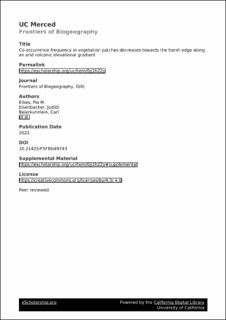Co-occurrence frequency in vegetation patches decreases towards the harsh edge along an arid volcanic elevational gradient<sup>a</sup>
Eibes, Pia M.; Eisenbacher, Judith; Beierkuhnlein, Carl; Chiarucci, Alessandro; Field, Richard; Jentsch, Anke; Köhler, Tina; Vetaas, Ole R.; Irl, Severin D.H.
Journal article, Peer reviewed
Published version

Åpne
Permanent lenke
https://hdl.handle.net/11250/2990387Utgivelsesdato
2021Metadata
Vis full innførselSamlinger
- Department of Geography [626]
- Registrations from Cristin [9404]
Sammendrag
Positive plant–plant interactions are thought to drive vegetation patterns in harsh environments, such as semi-arid areas. According to the stress-gradient hypothesis (SGH), the role of positive interactions between species (facilitation) is expected to increase with harshness, predicting associated variation in species composition along environmental gradients. However, the relation between stress and facilitation along environmental gradients is debated. Furthermore, differentiating facilitative interactions from other underlying mechanisms, such as microtopographic heterogeneity, is not trivial. We analysed the spatial co-occurrence relationships of vascular plant species that form patchy vegetation in arid lapilli fields (tephra) from recent volcanic eruptions on La Palma, Canary Islands. Assuming a harshness gradient negatively correlated with elevation because the lower elevations are more arid and water availability is considered the most limiting resource, and that an outcome of facilitation is plants co-occurring in the same patch, from the SGH we expected a greater degree of co-occurrence at lower elevation. We tested this at both the species and the individual plant level. We analysed the species composition of 1277 shrubby vegetation patches at 64 different sampling points, ranging from the coast to around 700 m a.s.l. Patch morphology and microtopographic heterogeneity variables were also measured, to account for their potential effects on the species composition of patches. We used generalized linear models and generalized mixed-effects models to analyse species richness, number of individuals in patches and percentage of patches with positive co-occurrences, and a pairwise co-occurrence analysis combined with a graphical network analysis to reveal positive links between 13 of the species. We found that the percentage of patches with positive co-occurrences increased at higher elevations, in contrast to the predictions of the SGH, but in accordance with a refined stress-gradient hypothesis for arid sites, in which characteristics of the interacting species are incorporated.
